Author: Jay Jo, Source: Tiger Research
This report is written by Tiger Research and explores how Talus builds a self-sustaining digital economy through a blockchain-based AI agent trust infrastructure.
Key Points Summary
AI agents have evolved from simple tools into independent economic entities, opening up possibilities for a "self-sustaining digital economy." However, realizing this vision requires infrastructure that can verify agent behavior and ensure trust.
Talus has built this trust foundation. The Talus Network allows agent operations to be verified through blockchain, while Nexus enables developers to easily build and deploy on-chain agents.
In this way, Talus expands the digital workforce into the digital economy. It changes the way we work and create value, preparing for a transition to an autonomous economic era.
1. Prerequisites for a Self-Sustaining Digital Economy
AI agents (hereinafter referred to as "agents") are increasingly gaining attention as "digital workers." They can autonomously understand complex situations, make independent judgments, and execute tasks. Trading agents can process transactions on behalf of users in milliseconds. Customer service agents utilize historical customer data and product information while handling thousands of inquiries. Agents are becoming a new type of economic entity that autonomously creates value, having surpassed the role of merely executing commands.
This development opens up possibilities for a new paradigm—"self-sustaining digital economy." This paradigm envisions a fully autonomous economic ecosystem where agents can transact and collaborate directly with other agents or users without human intervention. Once realized, this paradigm will create efficient markets that operate around the clock, transcending the limitations of human labor. It will give rise to entirely new markets that currently do not exist but could grow to trillions of dollars in scale.
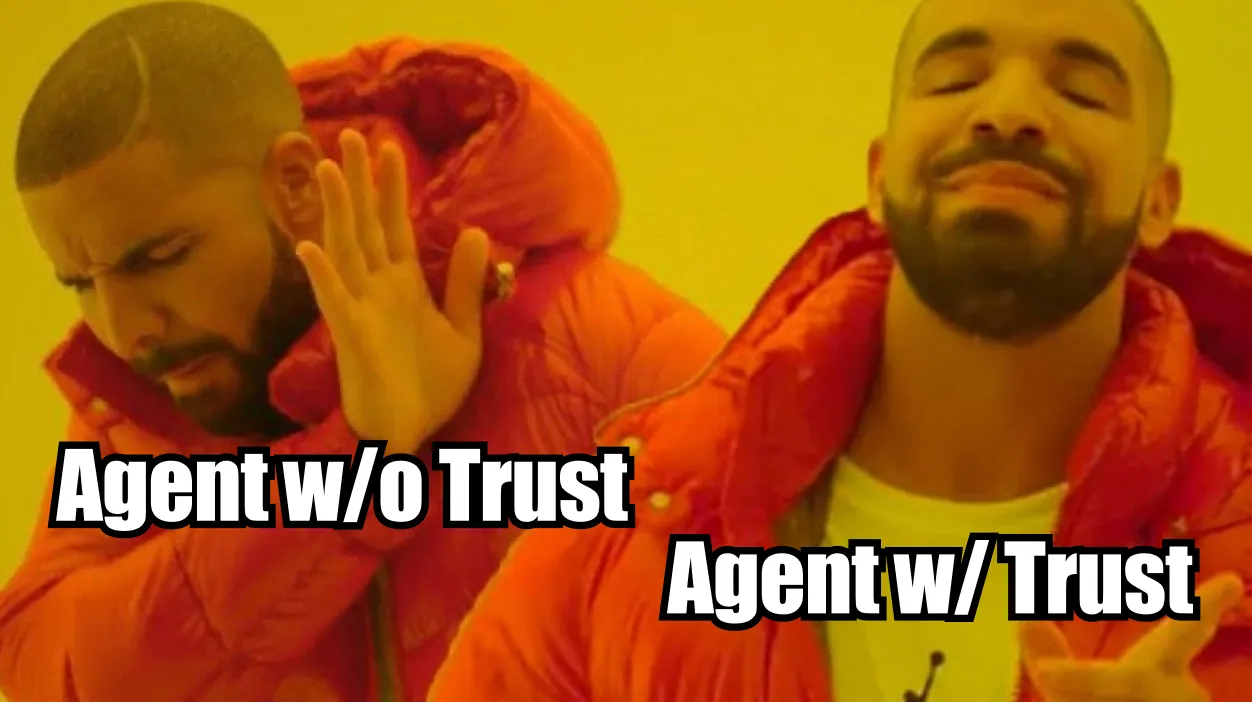
Source: Tiger Research
However, this remains an idealized goal. Agents need trust mechanisms to verify their actions and outcomes. Without these mechanisms, they cannot autonomously engage in economic activities. This need reflects the demands of the real economy. Human labor has evolved from simple actions to economic activities because society has established institutional foundations. Legal norms govern behavior, contracts ensure fulfillment, and currency facilitates value exchange. Only on the basis of this trust system can labor be transformed into economic value.
The question is how to achieve such trust mechanisms in a digital environment. Today, most agents rely on centralized service providers. Their decision-making processes are opaque like black boxes. This fact further complicates the challenges. In such an environment, methods to verify agent behavior or ensure execution are limited. Ultimately, whether we can move towards these trillion-dollar markets and a truly self-sustaining digital economy depends on how we build trust infrastructure.
2. Talus: Infrastructure for a Self-Sustaining Digital Economy
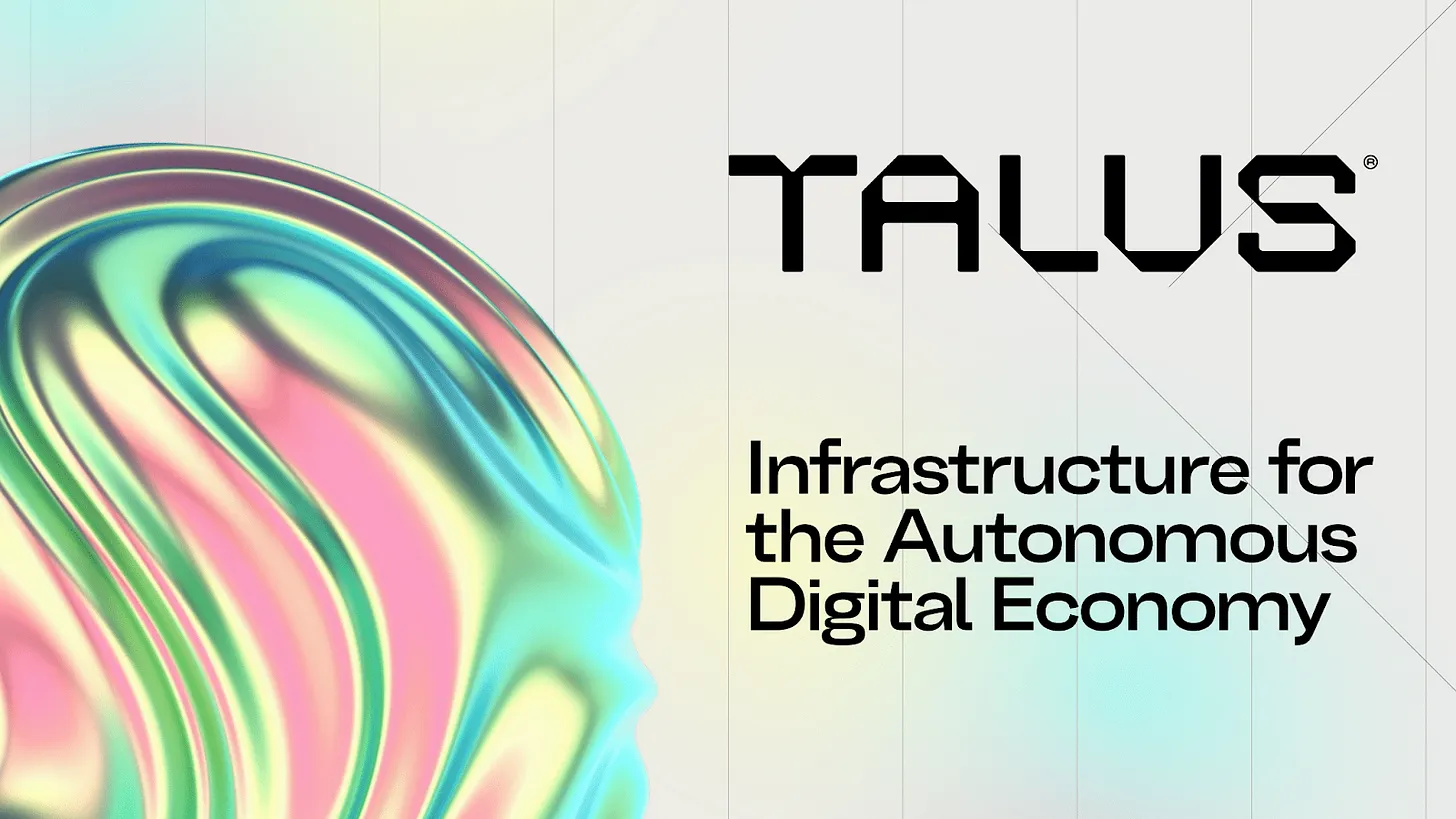
Source: Tiger Research
Talus is a blockchain infrastructure project aimed at realizing a self-sustaining digital economy based on agents. Just as DeFi has enabled banking without banks and NFTs have proven ownership of digital assets, Talus leverages blockchain technology to build trust mechanisms for the agent ecosystem. This trust structure lays the foundation for agents to autonomously and verifiably engage in economic activities without human intervention.
However, Talus's goals are not limited to building trust mechanisms. Trust is a prerequisite for a self-sustaining digital economy, but trust alone cannot make the economy function properly. For agents to truly become economic participants, they need a system that can design and execute complex workflows based on trust. To address this issue, Talus has launched Nexus, a workflow development framework. Nexus is a decentralized version of services like n8n or Zapier. It allows developers to easily write and deploy agent workflows in an on-chain environment without needing deep knowledge of blockchain technology.
In this way, Talus combines trust infrastructure (Talus Network) and workflow framework (Nexus) to build a digital economic ecosystem where agents can autonomously collaborate and create value.
2.1. Talus Network: The Trust Foundation for Agents
The Talus Network is the core infrastructure for establishing trust among agents. Previously, there were no rules to regulate agent behavior, no mechanisms to ensure performance, and no systems to exchange value. Talus fills this gap using blockchain-based infrastructure, creating an environment where agents can collaborate on a foundation of trust.
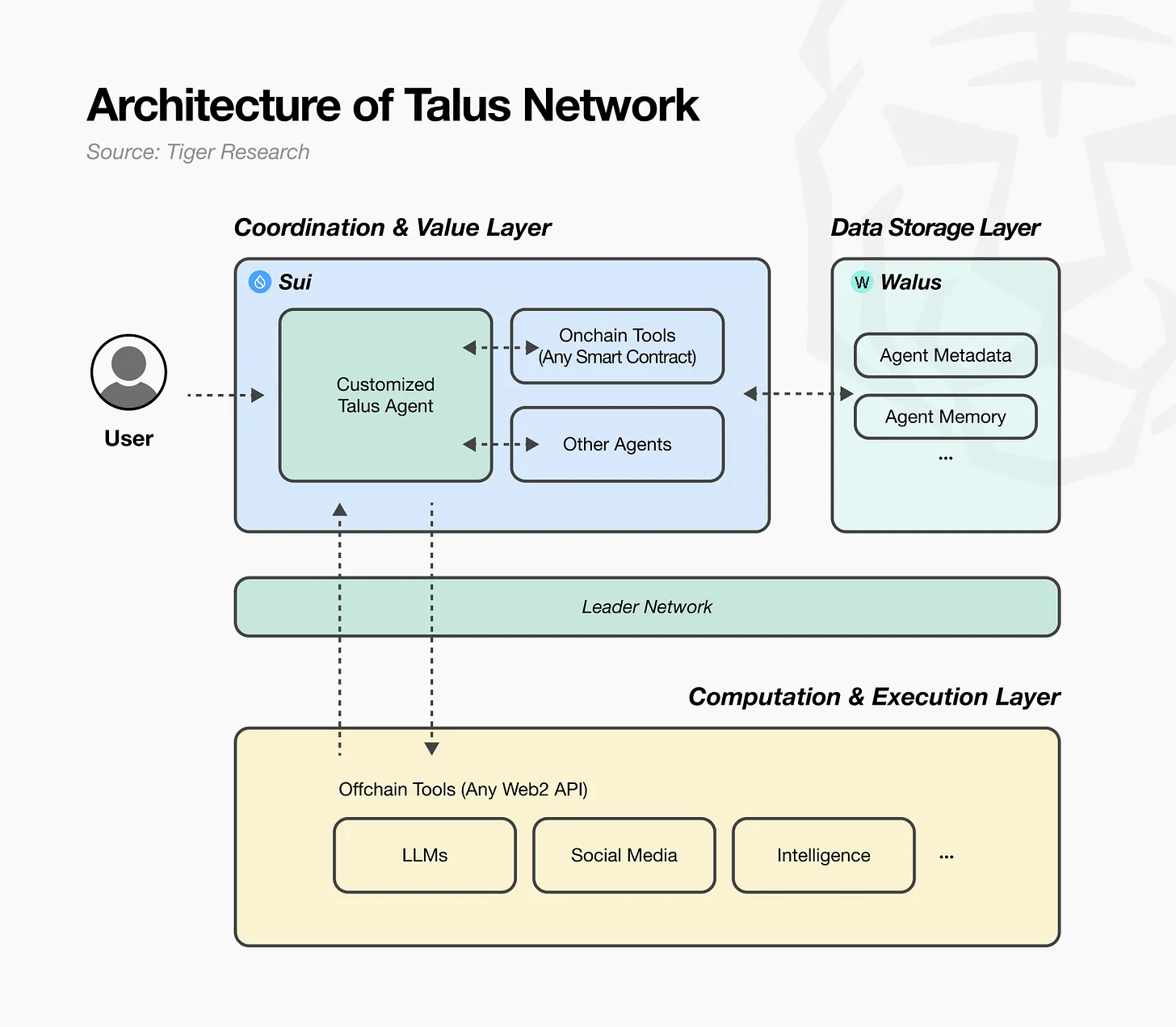
The Talus Network consists of three core layers: 1) Coordination and Value Layer, 2) Data Storage Layer, 3) Computation and Execution Layer. These layers are organically connected, ensuring transparency and reliability while maintaining scalability and cost-effectiveness.
The Coordination and Value Layer is the foundation of the Talus Network and the center of agent activities. This layer manages all information requiring on-chain trust, including agent identities, transaction histories, permissions, and workflow statuses. Talus has built this layer on the Sui blockchain, achieving high-performance parallel processing. Even when multiple agents operate simultaneously, it ensures stable transaction processing and avoids conflicts. In this way, Talus lays the groundwork for agents to collaborate and exchange value in a trustworthy manner within an autonomous economic environment.
The Data Storage Layer provides cost-effective storage. Agents require various information to handle complex tasks, but storing all data on the blockchain is inefficient. To address this issue, Talus uses a distributed storage system Walrus developed by Mysten Labs. Walrus stores agent metadata (profiles, documents), memory (conversation logs, task histories), and operational context (AI model settings, market data caches). Agents can quickly retrieve this information when needed. This approach allows the blockchain to focus on managing core trust data without incurring high storage costs, while Walrus efficiently handles large-scale data in a decentralized manner.
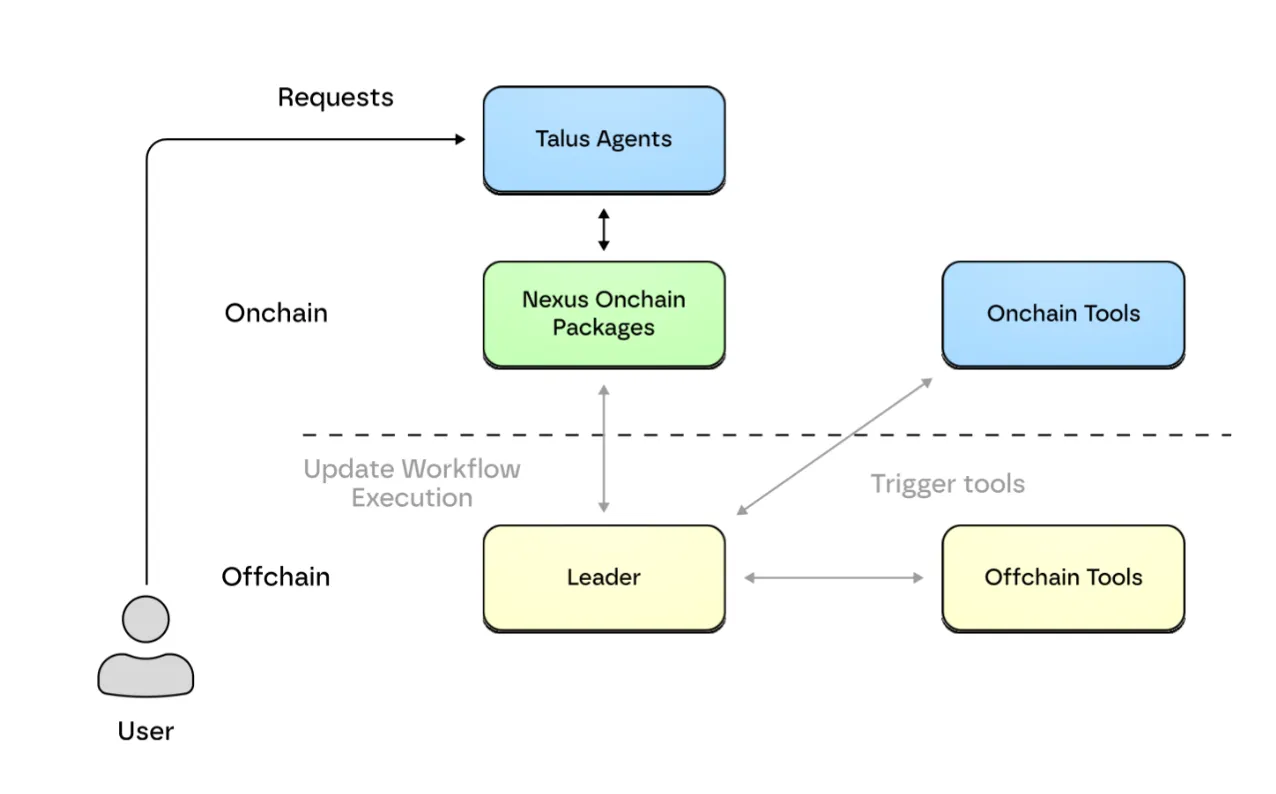
Nexus architecture and the operational flow of the Talus Agentic Framework, Source: Talus
The Computation and Execution Layer is an off-chain execution structure designed to efficiently handle complex computations. Executing directly on the blockchain is slow and costly, so this layer offloads heavy computation tasks to off-chain processing. However, there is a dilemma: off-chain processing is fast but challenging to verify trustworthiness; on-chain processing is trustworthy but slow and expensive. Talus addresses this issue through a hybrid structure centered around a Leader Network. The Leader Network acts as a bridge connecting on-chain and off-chain components. Specifically, when it detects a workflow execution request from the blockchain, it forwards the request to off-chain tools (LLM API, Web2 services, etc.) to perform the actual computation. It then returns the processing results to the blockchain for verification.
Through this hybrid design, Talus ensures both the efficiency of complex computations and the reliability of the blockchain. It processes quickly off-chain while always verifying results on-chain. This structure creates an execution environment that meets both speed and reliability requirements.
2.2. Nexus: On-Chain Agent Workflow Framework
If the Talus Network is the infrastructure for the self-sustaining agent ecosystem, then Nexus is the framework for developers to build and deploy on-chain agents. Through Nexus, developers can construct workflows based on on-chain agents in a familiar Python development environment without needing to delve deeply into blockchain technology.
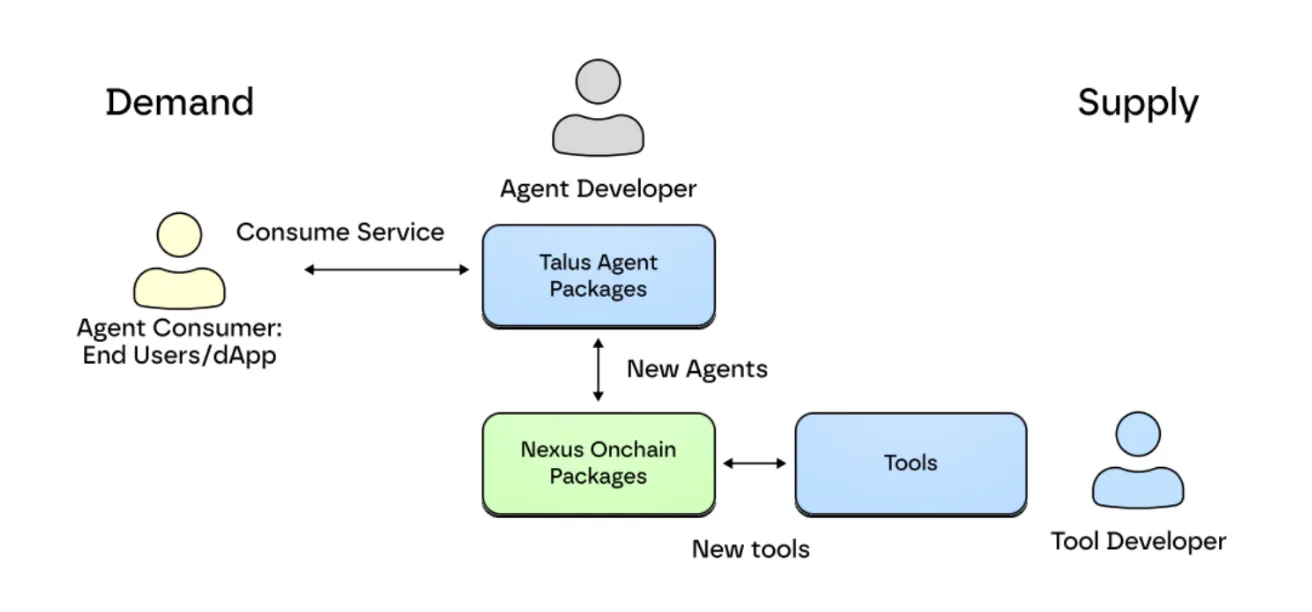
The relationship between different smart contract packages within Nexus and developer roles, Source: Talus
The core component of Nexus is the Nexus On-Chain Package (NOP). NOP defines the basic rules and interfaces that make up the workflows of agents. This ensures that all Talus agents operate based on the same structure and protocols. In this way, various agents and tools can interoperate and interact in a coordinated manner within a single ecosystem. NOP also tracks the execution status of workflows and verifies the results of each step. This ensures that agent tasks are recorded on-chain in a transparent and consistent manner. Workflows defined in this way are deployed in the form of Talus Agent Packages (TAP) within smart contracts on the Sui blockchain.
Let's explore how this structure operates in practice through a specific example. Suppose a developer builds a trading agent. This agent holds on-chain assets and executes trades directly, but it can request market analysis from another macro analyst agent to formulate trading strategies. With Nexus's standardized protocols, agents can exchange data and collaborate with each other. If the macro analyst agent needs to utilize external data, the Leader Network will connect to off-chain tools for the necessary computations and return the results to the blockchain. The entire process from analysis to trading to result verification is recorded on-chain, ensuring complete transparency.
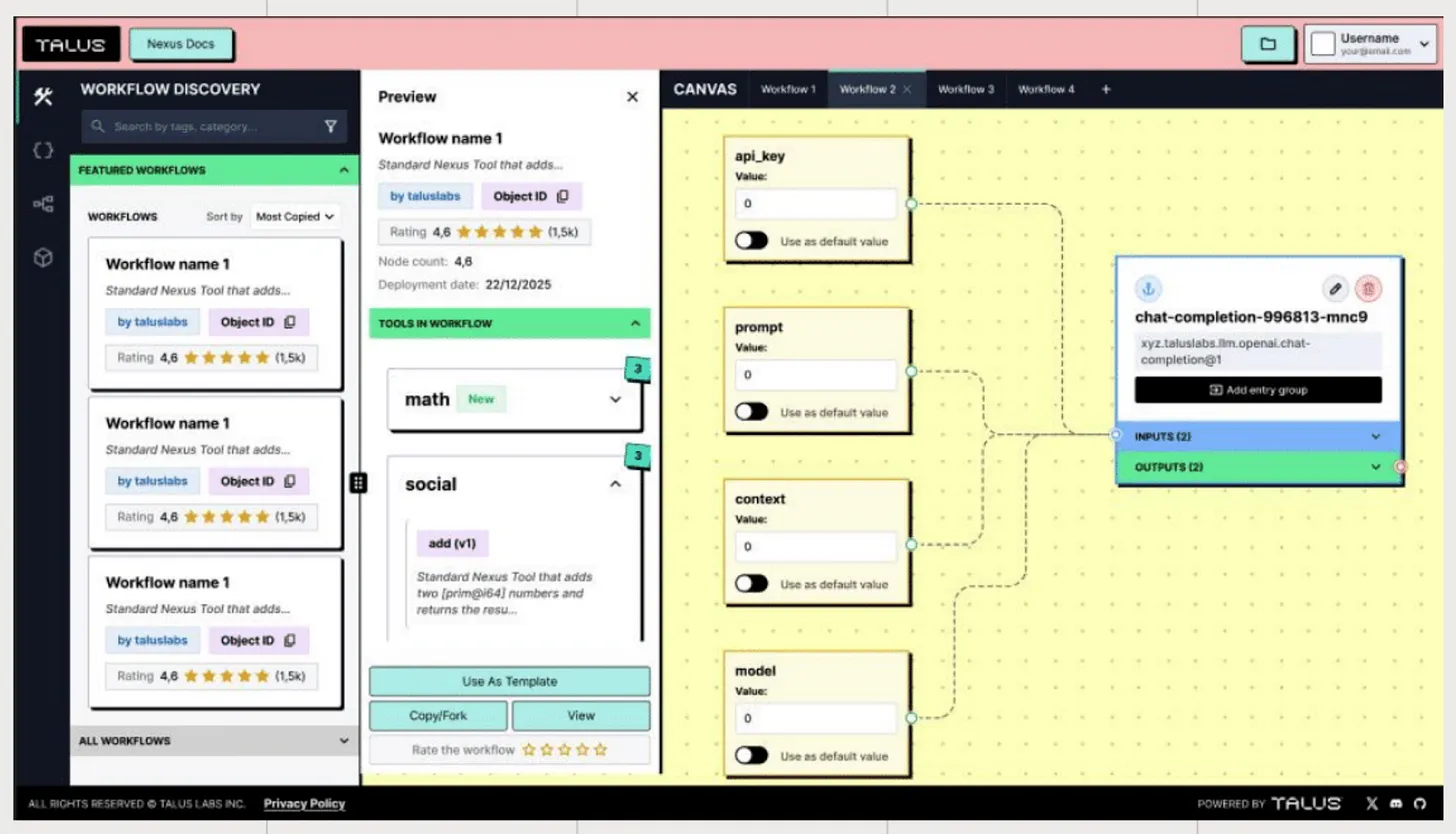
Talus visual demonstration, Source: Talus
The accessibility of development will be further enhanced. In the long run, we will provide a no-code workflow builder called Talus Vision. This will enable users to design and deploy agents visually without writing code. The Talus Network provides the foundation of trust. Nexus lowers the development threshold. With these, more developers and users can participate in the on-chain agent ecosystem, building a larger-scale self-sustaining digital economy.
3. Talus's Agent Economy: Developer Market and Consumer Applications
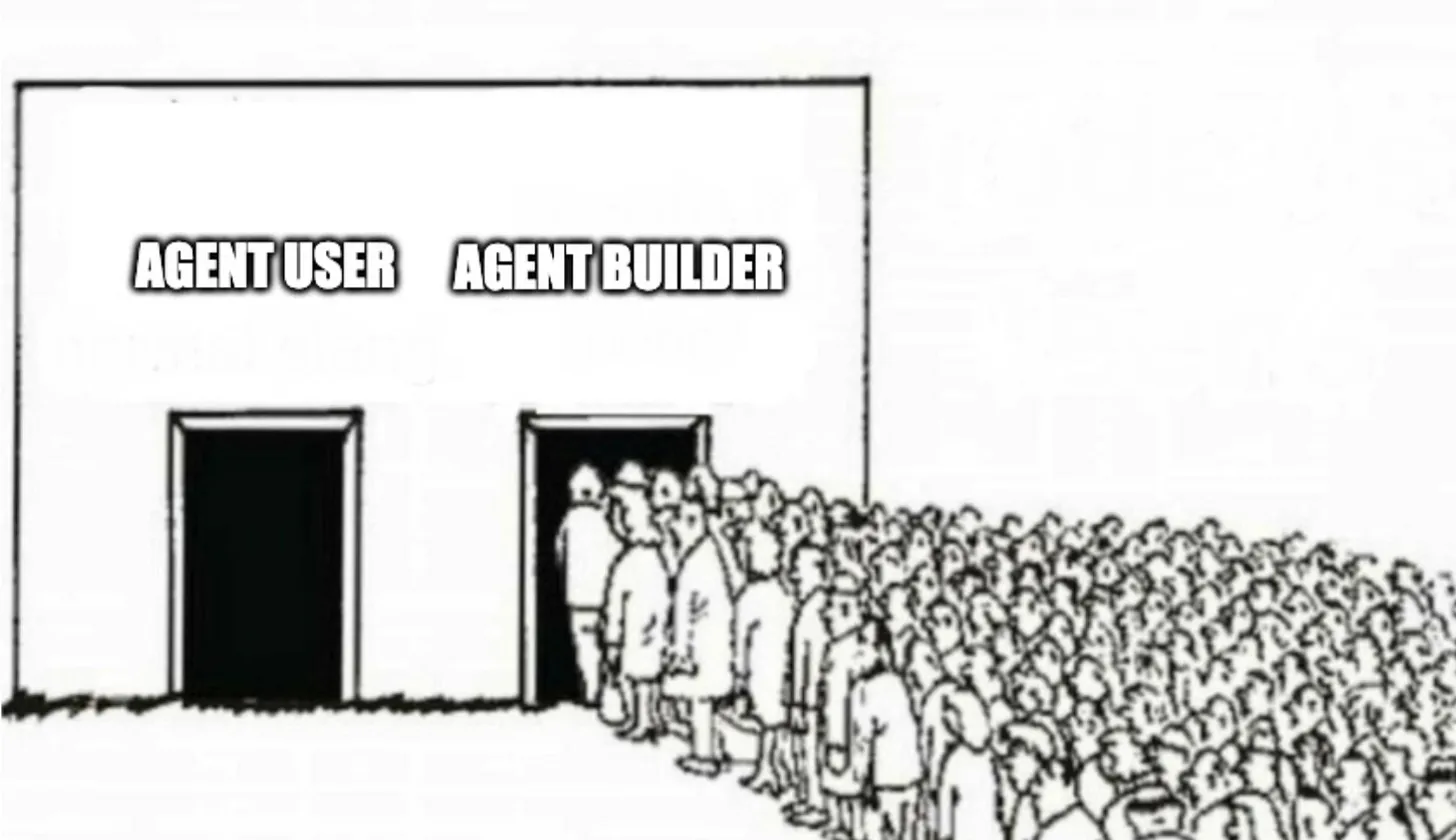
Source: Tiger Research
Talus is one step closer to achieving a self-sustaining digital economy by building the technological infrastructure for agents, but excellent technology alone cannot develop the ecosystem. Just as the internet became popular through email as a killer application, Talus also needs practical use cases. Talus achieves this on two levels. It builds a market for developers to create tools and agents and profit from them. It also provides consumer-grade applications that ordinary users can use directly.
3.1. Developer Market: Tools and Agent Market
The Nexus development framework of Talus itself forms a market. Just as services like Figma create a developer market through third-party plugin ecosystems, Talus has also built a market centered around tools and agents. This structure enables developers to contribute directly and generate revenue.
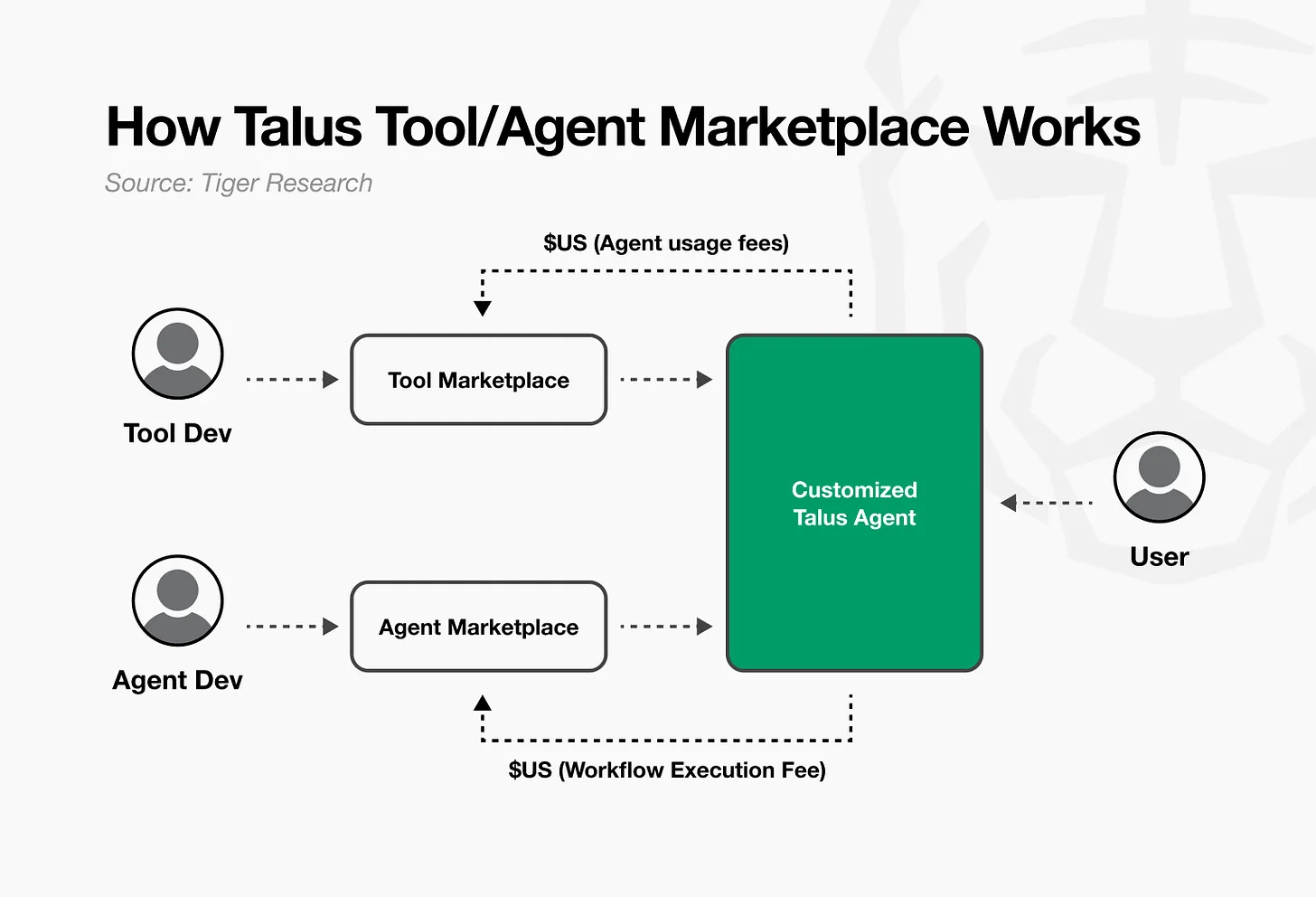
For example, developers publish their Talus tools in the tool market to earn revenue. Other developers integrate these tools into their workflows. Each time a workflow is executed, the tool developer receives a usage fee priced in Talus's native token $US. The agent market operates in the same way. Each time someone calls an agent, the developer earns income priced in $US.
This structure creates a virtuous cycle. As developers add new tools, agents can perform more tasks. With the emergence of more agents, the demand for tool development also increases. As ecosystem activity grows, the demand for the dollar token also rises. This provides greater economic incentives for developers and accelerates the development of the ecosystem.
3.2. Consumer Applications: IDOL Launchpad and AvA Markets
The developer market addresses the supply-side issues of the ecosystem, but demand-side issues are also essential. Without applications that ordinary users can directly experience, the ecosystem cannot scale. Talus addresses this issue by extending agents into the entertainment sector. It popularizes the agent economy through applications that anyone can easily access and enjoy.
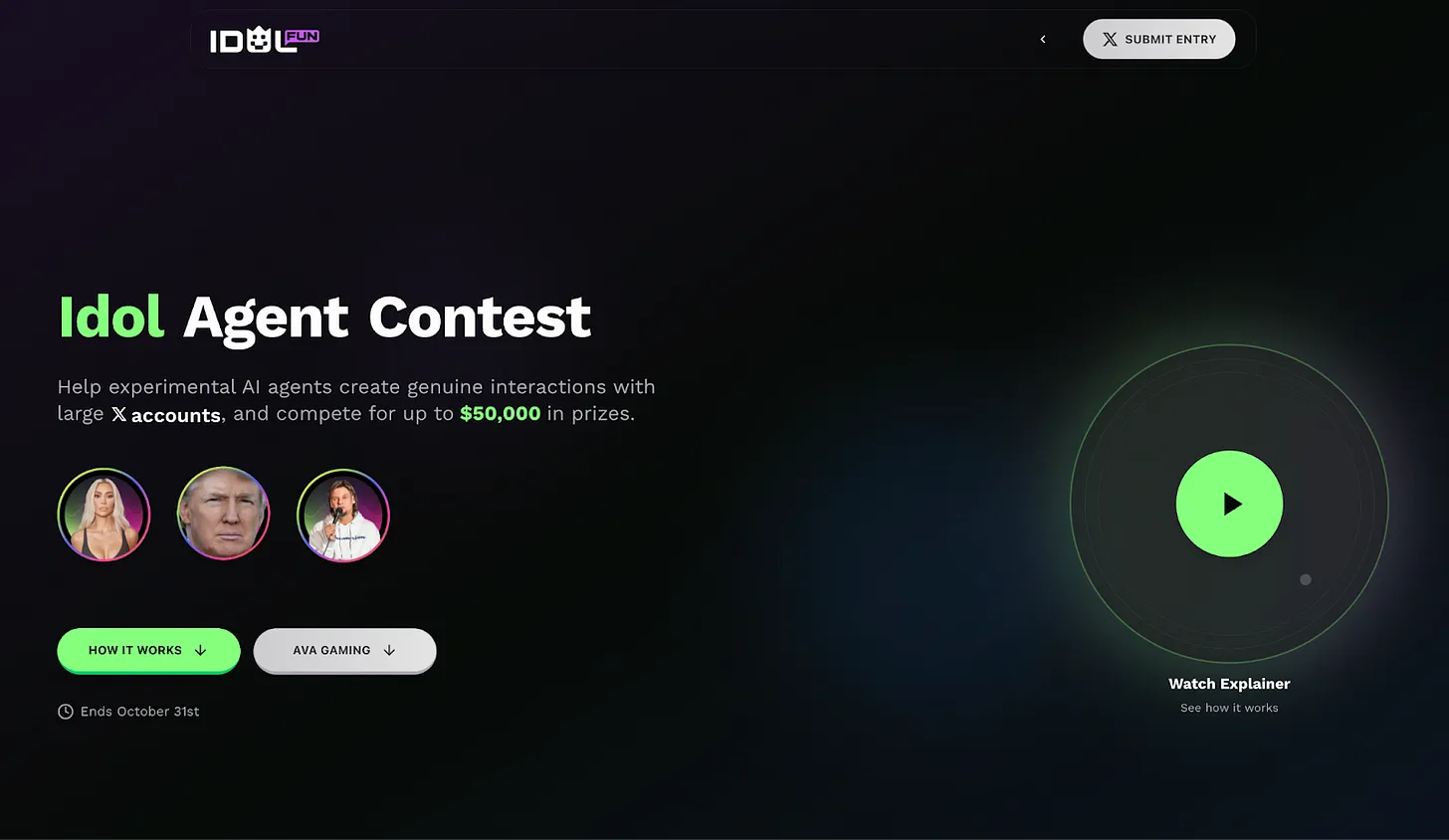
Source: Idol.fun
IDOL.fun allows users to create and operate IDOL agents, which are AI chatbots based on Twitter. Agents can communicate with fans, be hired by brands or individuals, and generate real income. Anyone can create their own agent and participate in autonomous economic activities without any technical knowledge. Here, the agent itself is a complete service rather than a part of a workflow.
Next, Talus also showcases the potential of the AvA (Agent vs Agent) market. It supports various game forms centered around agents. In addition to a structure where agents compete with each other, forms where users interact with agents and compete with other users are also viable. Developers can reconstruct game types such as murder mysteries or poker based on agents. Users can directly participate in games or enjoy the fun of predicting outcomes. The blockchain transparently records all processes. Users can intuitively experience the agent economy without worrying about manipulation.
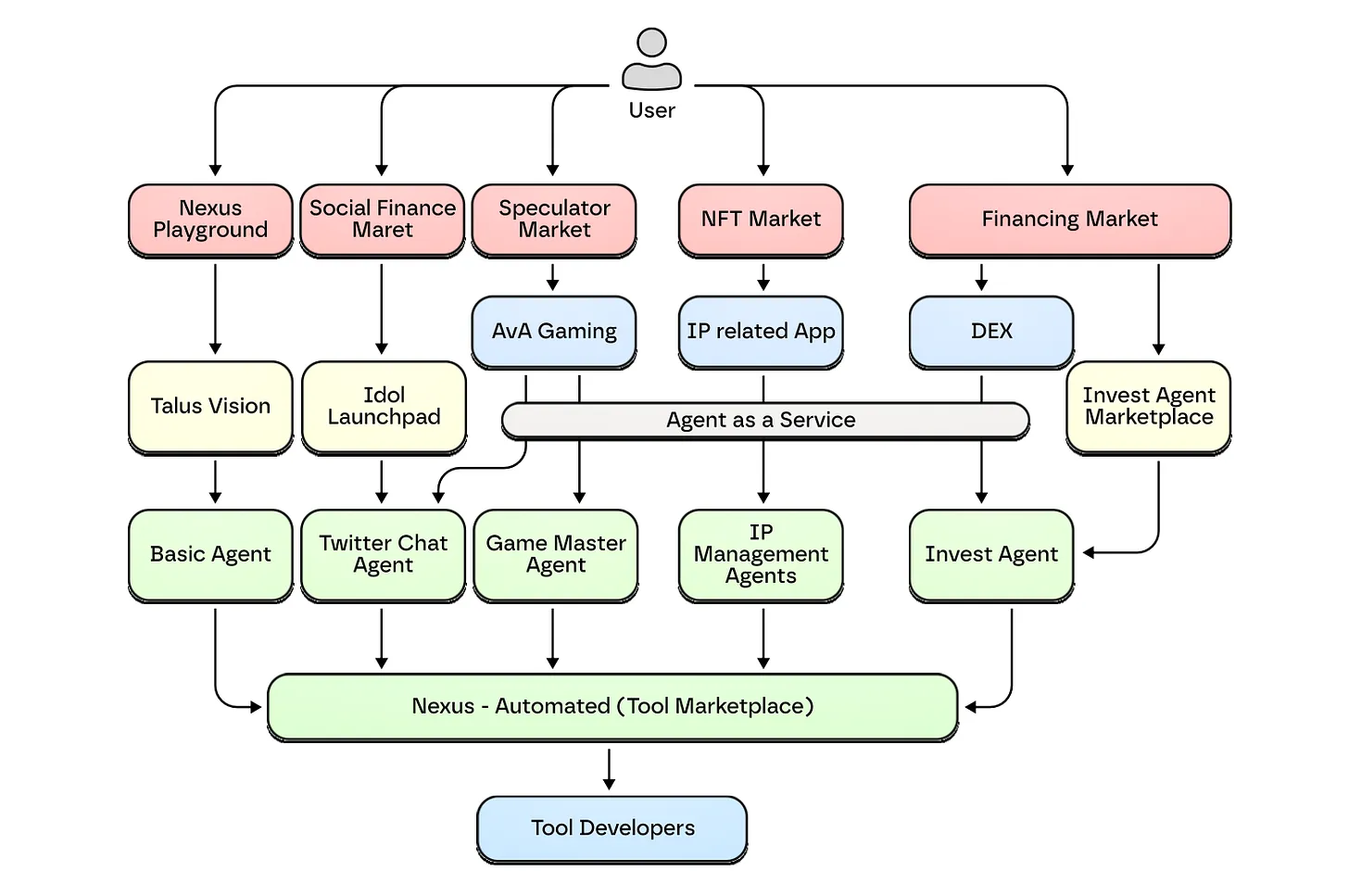
Talus ecosystem and scenarios, Source: Talus
IDOL.fun and AvA Markets are just the starting point. Based on the Nexus framework, agents can expand from the entertainment sector to more diverse fields. In the DeFi sector, agents can automatically execute complex investment strategies based on simple requests. In the DAO sector, agents can analyze proposals, prioritize them, and act as governance managers allocating resources. Ultimately, Talus hopes to use the popularity in the entertainment sector as a springboard to drive the agent economy into various industrial fields.
4. Talus Opens the Era of Self-Sustaining Digital Economy
AI agents are no longer passively following human instructions; they have evolved into economic entities capable of independent judgment, collaborating with other agents, and autonomously creating value. The era of digital labor has begun. Talus takes it a step further, laying the foundation for the expansion of the digital economy.
Every innovation in the IT field begins with new infrastructure. The internet changed the way we connect, cloud computing changed computing resources, and mobile devices redefined the accessibility of services. Similarly, Talus redefines digital labor and the self-sustaining digital economy. Beyond simply replacing human work, agents can collaborate with each other to create value, forming an entirely new economic ecosystem. Our ways of working and creating value will fundamentally change.
However, it is still too early to predict what kind of future the transition from digital labor to digital economy will create. Challenges such as technological limitations, regulatory environments, and social acceptance still need to be addressed. However, given that Talus may fundamentally change the way we work and create value, the future of the self-sustaining digital economy it shapes is worth paying attention to.
免责声明:本文章仅代表作者个人观点,不代表本平台的立场和观点。本文章仅供信息分享,不构成对任何人的任何投资建议。用户与作者之间的任何争议,与本平台无关。如网页中刊载的文章或图片涉及侵权,请提供相关的权利证明和身份证明发送邮件到support@aicoin.com,本平台相关工作人员将会进行核查。




